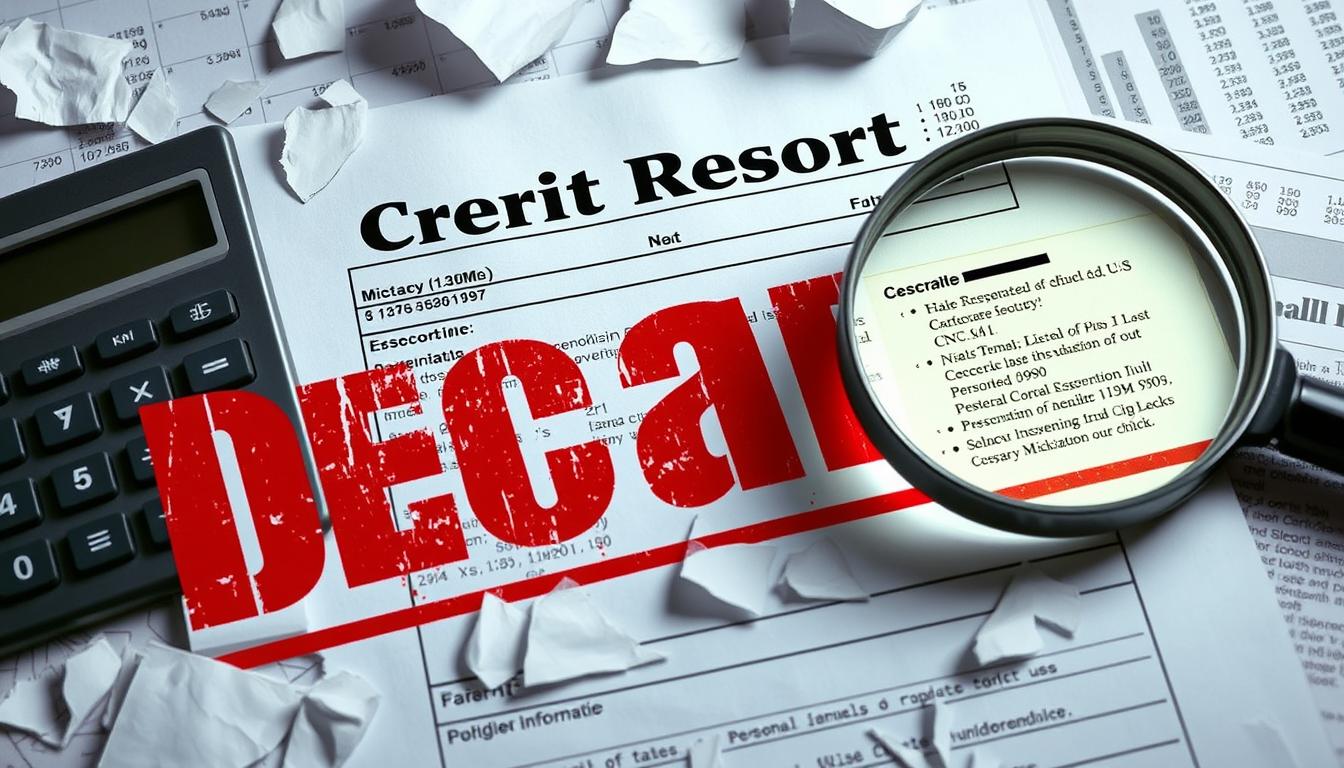A healthy credit history is vital for reaching your financial goals. It helps secure loans, rent apartments, and even land dream jobs. Negative marks on your credit report can hinder progress. The letter of deletion credit report offers a solution.
This guide explores credit reports and negative marks. We’ll uncover the power of deletion letters. You’ll learn about maintaining clean credit and the benefits of deletion letters.
We’ll walk you through crafting an effective deletion letter. You’ll get tips for successful credit disputes. We’ll cover handling creditor responses and rebuilding credit responsibly.
This guide equips you to tackle credit report issues. You’ll gain strategies to take control of your credit. Achieve the financial freedom you deserve.
Key Takeaways
- Understand the importance of maintaining a clean credit history for your financial well-being.
- Learn about the different types of negative marks that can appear on your credit report.
- Discover the purpose and benefits of using a letter of deletion credit report to remove negative items.
- Gain insight into the steps to write an effective letter of deletion credit report.
- Explore strategies for successful credit report disputes and handling creditor responses.
- Learn how to rebuild your credit responsibly after negative item removal.
- Discover the advantages of working with credit repair services to enhance your credit profile.
Understanding Credit Reports and Negative Marks
Credit reports detail your credit history, accounts, and payment record. They’re vital for a healthy credit score. Let’s explore credit reports and potential negative marks.
What is a Credit Report?
Credit reports are detailed records of your credit history. They’re compiled by Experian, Equifax, and TransUnion. These reports show your credit accounts, payment history, and credit inquiries.
They also include public records related to your credit. Lenders and landlords use these reports to assess your creditworthiness.
Types of Negative Marks on Credit Reports
Negative marks can greatly impact your credit score. They can affect your ability to get credit or housing.
- Late Payments: Missed or late payments can stay on your report for seven years.
- Collections: Unpaid debts sent to collection agencies can further damage your score.
- Charge-Offs: When creditors deem a debt uncollectible, it’s reported as a negative mark.
- Public Records: Bankruptcies, foreclosures, and tax liens can severely impact your score for years.
Knowing these negative marks helps identify issues affecting your creditworthiness. Understanding them is key to improving your credit score.
The Importance of Maintaining a Clean Credit History
A clean credit history is key to financial well-being. It affects your ability to get loans and credit cards. It also shows how responsible you are as a borrower.
Your credit score is based on your credit report. Lenders use this score to check if you’re creditworthy. A high score can lead to better interest rates and loan approvals.
A poor credit history can hurt your finances. Late payments and bankruptcies make it hard to get credit. They can also affect your job prospects in some industries.
Check your credit report often. Fix any errors you find. Use credit responsibly to keep your history clean. This can help you access better credit and lower interest rates.
| Benefits of a Clean Credit History | Consequences of a Poor Credit History |
|---|---|
|
|

“A clean credit history is the key to unlocking financial opportunities and securing your financial well-being.”
What is a Letter of Deletion Credit Report?
A letter of deletion credit report is a formal request to credit bureaus and creditors. It asks them to remove incorrect, unverified, or outdated negative items from your credit report. This tool helps you address any unfair information affecting your creditworthiness.
Purpose and Benefits of a Deletion Letter
The main goal of this letter is to boost your credit score and financial opportunities. Removing negative items can significantly improve your overall credit profile. This can lead to better interest rates and loan approvals.
Using a deletion letter offers several key benefits. It helps address inaccurate information on your credit report. It can improve your credit score by removing negative items.
This letter can enhance your chances of securing loans and credit cards. It may reduce the impact of past credit mistakes. Ultimately, it paves the way for improved financial stability.
Steps to Write an Effective Letter of Deletion Credit Report
A well-crafted deletion letter is vital for credit repair. It’s crucial to gather all necessary info and structure your request carefully. Let’s look at the key steps for writing a persuasive deletion letter.
Gathering Necessary Information
Start by carefully reviewing your credit report. Identify the specific negative item you want removed. Collect important details about the item.
These details include the creditor’s name, account number, and date of the negative mark. Also, summarize the item and gather any supporting documents.
Crafting the Letter
Now that you have the info, it’s time to write your letter. Include these key elements in your deletion request:
- Introduction: State your letter’s purpose and the item you want removed.
- Explanation: Briefly explain the negative item. Include details that show it’s inaccurate or unfair.
- Request for Deletion: Politely ask for the item’s removal. Cite relevant laws that support your right to do this.
- Conclusion: Thank them for their attention. Express your hope for a quick resolution.

The key to a good deletion letter is being clear and persuasive. Follow these steps to improve your credit report and boost your creditworthiness.
Tips for Successful Credit Report Disputes
Disputing credit report inaccuracies can boost your credit score. Follow these tips to tackle the dispute process effectively. You’ll have a better chance of success.
Start by carefully reviewing your credit report for errors. Document all evidence to support your claims. This will help when talking to credit bureaus and creditors.
- Gather all relevant documentation, such as billing statements, payment receipts, and any correspondence with creditors.
- Craft clear and concise dispute letters, outlining the specific errors or inaccuracies and the evidence supporting your claims.
- Submit your disputes directly to the credit bureaus, ensuring you follow their prescribed processes and deadlines.
- Follow up on your disputes regularly to ensure they are being addressed in a timely manner.
Good communication is vital when disputing credit report errors or credit report inaccuracies. Be firm but polite with credit bureaus and creditors. Provide all needed info to back up your credit report disputes.
Don’t hesitate to escalate if you face resistance. Stay persistent throughout the process.
Taking proactive steps to address credit report errors can have a significant impact on your credit score improvement and overall financial well-being.
The credit repair strategies you use during disputes can have lasting benefits. Removing negative items can strengthen your credit history. This sets you on a path to better financial health.
| Action | Benefit |
|---|---|
| Thoroughly review your credit report | Identify and document any errors or inaccuracies |
| Gather supporting evidence | Strengthen your dispute claims |
| Communicate effectively with credit bureaus and creditors | Increase the chances of successful dispute resolution |
| Follow up on your disputes | Ensure timely and satisfactory resolution |
Letter of Deletion Credit Report
Spotting errors on your credit report is vital for financial health. Review your credit report errors and credit report inaccuracies carefully. You can then dispute and remove negative items unfairly affecting your credit report.
Recognizing Common Negative Items
Look for these negative items when checking your credit report. They may be removable through a letter of deletion credit report:
- Accounts that do not belong to you
- Credit report disputes related to identity theft or fraud
- Inaccurate payment histories or account statuses
- Outdated or obsolete credit report information
- Duplicate or erroneous public records, such as liens or bankruptcies
Gather solid evidence to support your case for a letter of deletion credit report. This can include bank statements and billing records. Strong documentation will boost your credit repair efforts.
| Common Credit Report Errors | Potential Impact on Credit Score |
|---|---|
| Incorrect account information | Up to 100 points |
| Duplicate accounts | Up to 50 points |
| Inaccurate public records | Up to 150 points |
Reviewing and disputing credit report errors or credit report inaccuracies is crucial. This process can significantly improve your financial health and credit profile.

Handling Creditor Responses and Follow-Ups
Dealing with creditors and credit bureaus can be tricky. A strategic approach is key when addressing credit report issues. Your success depends on how you handle creditor responses.
If a creditor agrees to remove a negative mark, maintain clear communication. Provide any required documents promptly. Keep a close eye on your dispute’s progress.
For uncooperative creditors, step up your game. Gather evidence like payment receipts or error documentation. Resubmit your dispute politely but firmly. Persistence often convinces stubborn creditors to reconsider.
Credit repair is an ongoing process. Being prepared for challenges can make a big difference. It can lead to successful removal of negative items. This, in turn, can improve your credit score.
| Creditor Response | Recommended Actions |
|---|---|
| Cooperative |
|
| Resistant |
|
A strategic approach to credit report disputes can lead to success. Stay committed to following through. This can help you address credit issues effectively. Ultimately, it can improve your overall financial health.
Improving Your Credit Score After Negative Item Removal
After removing negative items from your credit report, focus on rebuilding your credit profile. This step is vital for credit score improvement and financial responsibility. It’s a key part of your journey to better credit.
Rebuilding Credit Responsibly
For lasting credit repair and a healthy credit history, adopt responsible credit management practices. These strategies can help you rebuild your credit effectively.
- Make timely payments on all your bills and loans to demonstrate financial reliability.
- Keep your credit card balances low, ideally below 30% of your available credit limit.
- Diversify your credit mix by having a combination of different types of accounts, such as credit cards, installment loans, and mortgages.
- Monitor your credit report regularly and address any new inaccuracies or errors promptly.
Applying these principles consistently can help you improve your credit score. It will also build a strong financial foundation for your future.

“The key to long-term credit score success is to develop and maintain good credit management habits.”
Credit repair is an ongoing process that requires patience and diligence. With time, you can achieve your financial responsibility goals. This will open new doors for growth and success.
Working with Credit Repair Services
Professional credit repair services can help improve your credit score and financial well-being. These companies offer expertise in handling credit report disputes and cleanup. They can be a valuable option for those who need assistance.
Credit repair specialists excel at spotting errors on your credit report. They understand credit law and can efficiently initiate credit report disputes. These experts work with creditors to remove negative items from your record.
These services provide guidance throughout the credit improvement process. They help you understand your credit profile and develop a personalized plan. Their support ensures you maintain good credit management practices.
Choose a reputable credit repair service with care. Look for companies with proven success and positive customer reviews. Avoid services promising unrealistic or quick-fix solutions, as they may be scams.
Investing in a credit repair service can benefit your financial future. It can help you achieve your credit management goals effectively. With their help, you can maintain a healthy credit score long-term.
Preventing Future Credit Report Issues
Keeping a clean credit report and healthy score requires ongoing effort. Adopting responsible credit management practices is key to avoiding future problems. These practices protect your credit health and ensure long-term financial well-being.
Responsible Credit Management Practices
Here are some key strategies to prevent future credit report issues:
- Monitor your credit report regularly: Check reports from all three major bureaus yearly. Look for errors or suspicious activity.
- Dispute errors promptly: Address inaccuracies immediately by contacting credit bureaus. This maintains the integrity of your credit history.
- Manage credit card balances: Keep balances below 30% of your credit limit. This helps maintain a favorable credit utilization ratio.
- Make timely payments: Pay all credit accounts on time. This is crucial for building a positive credit history.
These practices protect your credit report and credit score. They lead to a more financially secure future.
“Maintaining a good credit report is like building a strong foundation for your financial future. It takes diligence, but the rewards are invaluable.”
Conclusion
A letter of deletion credit report can remove negative marks and boost your credit score. Understanding credit reports and negative items empowers you to manage your credit effectively. These tools help you achieve your financial goals.
A clean credit report is crucial for financial success. It leads to better interest rates and loan terms. You can dispute errors and negative marks using the steps we’ve discussed.
Credit report cleanup and credit score improvement require ongoing effort. Adopt responsible credit management habits and monitor your report regularly. This approach will help maintain a healthy credit profile.
With dedication and smart strategies, you can enjoy long-term financial well-being. Keep working on your credit to unlock better opportunities and financial freedom.

